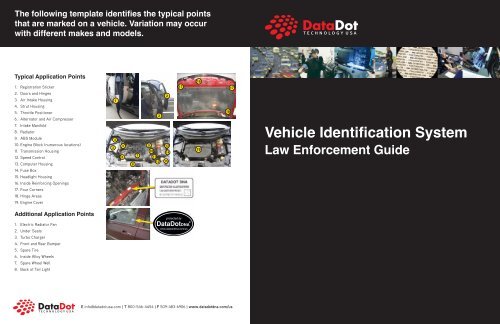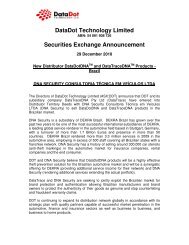Vehicle Identification System - DataDot Technology
Vehicle Identification System - DataDot Technology
Vehicle Identification System - DataDot Technology
You also want an ePaper? Increase the reach of your titles
YUMPU automatically turns print PDFs into web optimized ePapers that Google loves.
The following template identifies the typical points<br />
that are marked on a vehicle. Variation may occur<br />
with different makes and models.<br />
Typical Application Points<br />
1. Registration Sticker<br />
2. Doors and Hinges<br />
3. Air Intake Housing<br />
4. Strut Housing<br />
5. Throttle Positioner<br />
6. Alternator and Air Compresser<br />
7. Intake Manifold<br />
8. Radiator<br />
9. ABS Module<br />
10. Engine Block (numerous locations)<br />
11. Transmission Housing<br />
12. Speed Control<br />
13. Computer Housing<br />
14. Fuse Box<br />
15. Headlight Housing<br />
16. Inside Reinforcing Openings<br />
17. Four Corners<br />
18. Hinge Areas<br />
19. Engine Cover<br />
<strong>Vehicle</strong> <strong>Identification</strong> <strong>System</strong><br />
Law Enforcement Guide<br />
Additional Application Points<br />
1. Electric Radiator Fan<br />
2. Under Seats<br />
3. Turbo Charger<br />
4. Front and Rear Bumper<br />
5. Spare Tire<br />
6. Inside Alloy Wheels<br />
7. Spare Wheel Well<br />
8. Back of Tail Light<br />
E info@datadotusa.com | T 800-546-4454 | F 509-483-6906 | www.datadotdna.com/us
<strong>DataDot</strong>DNA ®<br />
a simple, effective and permanent method<br />
of marking and identifying vehicles.<br />
About <strong>DataDot</strong>DNA ®<br />
<strong>DataDot</strong>s are a state-of-the-art identification technology<br />
which allows any asset to be quickly and effectively marked<br />
with its own unique “DNA.” Single inscribed microdots<br />
were originally developed by the U.S. military in the 1940s to<br />
covertly tag or identify items.<br />
Each <strong>DataDot</strong> is the size of a grain of sand and is laser-etched<br />
with a unique identifying code. Hundreds of the tiny dots are<br />
sprayed onto the protected asset with an ultraviolet adhesive.<br />
Although nearly invisible to the naked eye, they can be found<br />
easily by using a simple ultraviolet blacklight.<br />
The <strong>DataDot</strong> database is accessible by Law Enforcement<br />
agencies 24 hours a day, allowing instant identification.<br />
Where Are Datadots Sold And<br />
Installed<br />
<strong>DataDot</strong> maintains strict control on the manufacture,<br />
distribution and fitment of <strong>DataDot</strong>s.<br />
The automotive product is only sold and fitted by authorized<br />
vehicle dealers in the US and Canada. Please contact <strong>DataDot</strong><br />
USA for an up to date list of active dealerships in your area.<br />
<strong>Vehicle</strong> manufacturers have also recalled vehicles for fitment<br />
of <strong>DataDot</strong>s to selected vehicle parts to combat thieves. The<br />
Nissan Maxima recall in the Northeast region of the US was<br />
an example of the use of <strong>DataDot</strong>s to effectively reduce theft<br />
and combat crime.<br />
Datadots - DNA For Any <strong>Vehicle</strong>.<br />
Each vehicle is marked with a minimum of 1,000 uniquely<br />
coded <strong>DataDot</strong>s which are simply brushed on the chassis,<br />
compliance plates and high theft engine components.<br />
<strong>DataDot</strong>s may also be applied to other parts of the vehicle<br />
including alloy wheels, DVD's and stereo equipment.<br />
The information coded on the Dot is either the original<br />
manufacturers VIN number, or a unique PIN number which<br />
is linked to the VIN of the vehicle through national databases<br />
only accessible by law enforcement.<br />
Every vehicle fitted with <strong>DataDot</strong> is identifiable through the<br />
NICB/ISO national database and via the National <strong>DataDot</strong><br />
database for the life of the vehicle. Window and engine<br />
warning decals are also fitted to every marked vehicle to aid<br />
in theft deterrence and recovery.<br />
As it is near impossible to remove the 1000's of <strong>DataDot</strong>s<br />
applied to a vehicle, professional thieves run a very high<br />
chance of being either caught with stolen items or can be<br />
identified later as the distributor of stolen parts through the<br />
finding of just ONE <strong>DataDot</strong>.<br />
How Are Dots Located And Read<br />
<strong>Vehicle</strong> window<br />
activation stickers and<br />
an engine decal quickly<br />
identify if dots have<br />
been fitted to a vehicle.<br />
If the warning decals<br />
have been removed,<br />
then standard law<br />
enforcement blacklights<br />
will quickly identify<br />
the presence of <strong>DataDot</strong>s as the adhesive will fluoresce<br />
on marked components. A fitment template is enclosed<br />
highlighting key marking points by dealers.<br />
The Dots are read using a simple 30x or greater magnifying<br />
reader. Readers are commonly available from most electronic<br />
or hardware stores. Once the dot is read, law enforcement<br />
can quickly identify the true owner of the asset using either<br />
the National vehicle database.<br />
Where a PIN is used in lieu of the full VIN, the NICB provides<br />
law enforcement agencies the ability to conduct a search<br />
of stored <strong>DataDot</strong> information on the National Insurance<br />
Services Office (ISO) database which references each PIN<br />
with databases of automobile VIN and manufacturer shipping<br />
and assembly records.<br />
In the case of all other assets, police can check the PIN<br />
against the National <strong>DataDot</strong> USA database by direct access<br />
through the Internet (Access codes are only available to police<br />
by calling <strong>DataDot</strong>sUSA toll-free at 1 800 546 4454.<br />
What About Canada And Mexico<br />
It is a sad fact that many vehicles stolen in the US are moved<br />
over national borders either in part or whole. <strong>DataDot</strong>s are<br />
available for sale in the US, Canada and Mexico.<br />
All vehicles fitted are identifiable by law enforcement in each<br />
country, or across national borders, through the National<br />
<strong>DataDot</strong> database. <strong>DataDot</strong> is actively working with Canadian<br />
and Mexican regulatory authorities and their law Enforcement<br />
in continuing to build overall awareness.<br />
How Can Law Enforcement Use<br />
Dots<br />
<strong>DataDot</strong>s are actively used by Law Enforcement, divisions of<br />
the FBI, other regulators and insurance agents in covert sting<br />
operations. These operations typically focus on auto theft,<br />
theft and re-sale of stolen parts and insurance fraud.<br />
Authentication Of Police Badges<br />
<strong>DataDot</strong> has partnered with Smith & Warren, one of the<br />
largest manufacturers of law enforcement badges in the US,<br />
with Dots now being incorporated into the finished badge<br />
product. This technology adds authenticity and proof of<br />
ownership to law enforcement and other regulatory badges.<br />
How Secure Is The Registration<br />
Information<br />
Access to information about vehicles fitted with <strong>DataDot</strong>s<br />
is only available to law enforcement, the NICB and other<br />
approved regulatory bodies in North America.<br />
Such security ensures the integrity of the <strong>DataDot</strong><br />
information, helps detect vehicle rebirthing and ensures that<br />
customer privacy is ensured at all times.<br />
For more information:<br />
web: www.datadotusa.com<br />
email: lea@datadotusa.com<br />
call: 1-800-546-4454




